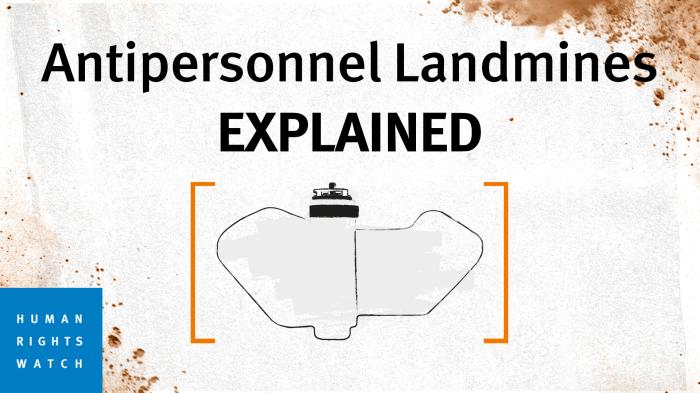(Washington, DC, November 20, 2024) – The Biden administration’s decision to transfer internationally banned antipersonnel landmines to Ukraine risks civilian lives and rejects the most successful humanitarian disarmament treaty of the past 25 years, Human Rights Watch said today.
On November 19, 2024, the Washington Post reported that US President Joe Biden had authorized providing antipersonnel mines to Ukraine, which US Defense Secretary Lloyd Austin confirmed on November 20. “They’ve [Ukraine] asked for these, and so I think it’s a good idea,” Austin told the New York Times.
“President Biden’s decision to transfer antipersonnel landmines risks civilian lives and sets back international efforts to eradicate these indiscriminate weapons,” said Mary Wareham, deputy crisis, conflict and arms director at Human Rights Watch. “The US should reverse this reprehensible decision, which only increases the risk of civilian suffering in the short and long term.”
A majority of the world’s countries rejected antipersonnel landmines decades ago due to their indiscriminate nature and the long-term human suffering that they cause, Human Rights Watch said.
Antipersonnel mines are designed to explode in response to a person’s presence, proximity, or contact. They are typically placed by hand, but they can also be scattered by aircraft, rockets, and artillery or dispersed from specialized vehicles. Antipersonnel mines cannot distinguish between soldiers and civilians, making them unlawfully indiscriminate under international humanitarian law. Uncleared landmines pose a danger until cleared and destroyed. Mined land can drive displacement of the civilian population, hinder the delivery of humanitarian aid, and prevent agricultural activities. Civilians made up 84 percent of all recorded landmine casualties in 2023, while children were 37 percent of casualties when the age was recorded.
The United States has not used antipersonnel mines since 1991, has not exported them since 1992, has not produced them since 1997, and had no plans for future procurement. Over the past 30 years, the US has destroyed antipersonnel mines from its stockpile and has spent more than $1 billion on the development and production of systems that could be considered alternatives to antipersonnel mines.
On June 21, 2022, President Biden announced a policy committing the US not to use antipersonnel mines anywhere in the world, except on the Korean Peninsula, and set the goal of ultimately joining the Mine Ban Treaty. Under that policy, the US committed to destroy antipersonnel mine stockpiles that are “not required for the defense of the Korean Peninsula.” It promised that it would not develop, produce, or acquire antipersonnel mines. The policy explicitly requires the US “not [to] assist, encourage, or induce anyone, outside the context of the Korean Peninsula, to engage in activity that would be prohibited” by the Mine Ban Treaty.
In September 1994, the US became the first country to call for the “eventual elimination” of antipersonnel landmines and participated in the 1996-1997 Ottawa Process that created the Mine Ban Treaty. The US did not adopt or sign the Mine Ban Treaty in 1997, but the Clinton administration set the goal for the US to join the treaty in 2006. The George W. Bush administration reversed that objective in 2004.
In 2014, the Barack Obama administration issued a US landmine policy banning the production and acquisition of antipersonnel mines, as well as halting their use by US forces anywhere except on the Korean Peninsula. In January 2020, then-president and current President-elect Donald Trump canceled a policy that would have eliminated all antipersonnel mines in the US stockpile.
The existing US stockpile of antipersonnel mines is expected to expire—meaning that the mines will become unusable—by the early 2030s, in part because their 36-year shelf-life decreases over time as batteries embedded inside the mines deteriorate with age. The 2014 policy precluded the US from extending or modifying the life of the batteries in its stockpiled antipersonnel mines. The 2022 policy was understood to continue that practice.
The Mine Ban Treaty entered into force on March 1, 1999; it comprehensively bans antipersonnel mines and requires destruction of stocks, clearance of mined areas, and assistance to victims. A total of 164 countries have joined the treaty, including all NATO member states, except the US; all European Union member states; and US allies such as Australia, Japan, and Ukraine. Ukraine ratified the Mine Ban Treaty on December 27, 2005, while Russia has not joined it.
The US transfer decision comes days before the Fifth Review Conference of the Mine Ban Treaty, to be held in Siem Reap, Cambodia from November 25-29. The US and Ukraine have registered to attend the event, also known as the Siem Reap Summit on a Mine-Free World.
Russia has used antipersonnel landmines widely in Ukraine since its full-scale invasion of the country on February 24, 2022, causing hundreds of casualties and contaminating vast tracts of agricultural land. Russia has also created an unprecedented situation in which a country that is not party to the Mine Ban Treaty is using the weapon on the territory of a treaty party.
Human Rights Watch has also documented Ukrainian use of antipersonnel mines in violation of the Mine Ban Treaty in and around the city of Izium, Kharkivska province, in 2022, when the city was under Russian control. Ukrainian authorities have said they are investigating reports that forces used rocket-fired antipersonnel mines.
By accepting and using antipersonnel mines, Ukraine risks further violating the Mine Ban Treaty, Human Rights Watch said. Under article 20 of the Mine Ban Treaty, a state party engaging in armed conflict is not allowed to withdraw from the treaty before the end of the armed conflict. The treaty is also not subject to reservations.
“Russian forces have repeatedly used antipersonnel mines and committed atrocities against civilians across Ukraine in violation of the laws of war, but this doesn’t justify transferring and using prohibited weapons,” Wareham said. “Abiding by international protections for civilians means working to ensure that antipersonnel mines are never used again.”
Human Rights Watch is a co-founder of the International Campaign to Ban Landmines, which received the 1997 Nobel Peace Prize, together with its coordinator, Jody Williams, for its efforts to bring about the Mine Ban Treaty and for its contributions to a new international diplomacy based on humanitarian imperatives.










